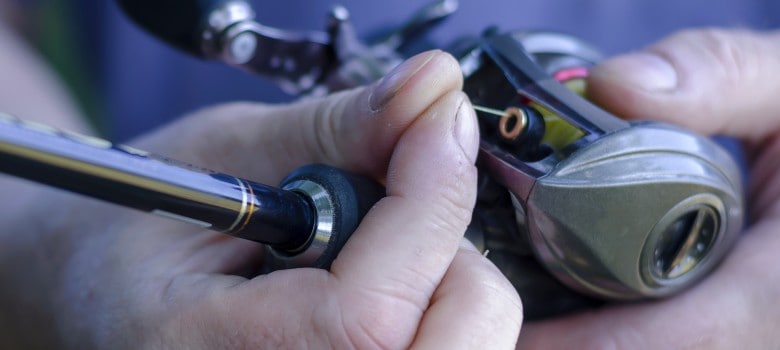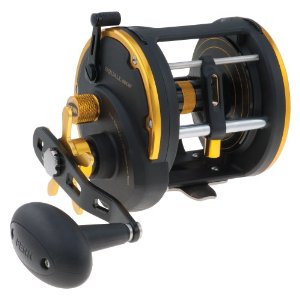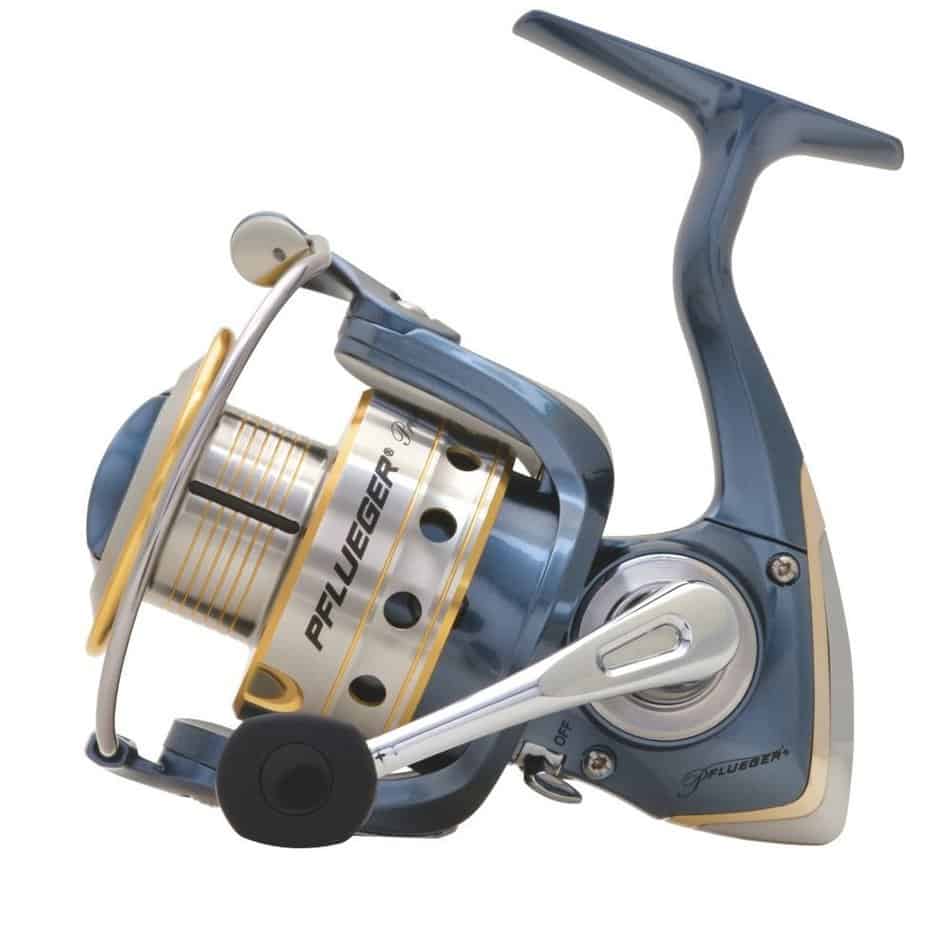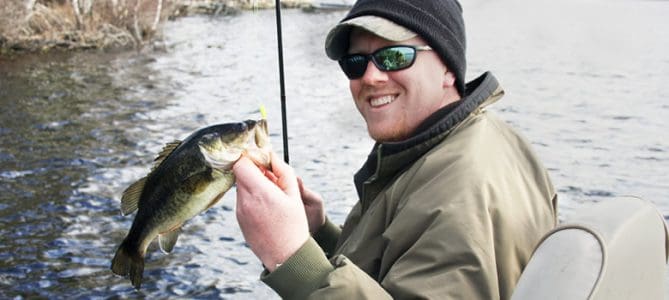If you buy via a link on this page, we may receive a commission, at no extra cost to you.Learn more
Fishing with a baitcaster can be very tempting, considering their popularity and effectiveness. But understanding a baitcaster’s makeup and components, especially its brakes, is vital for anyone hoping to fish with this intricate reel.
Unlike a spinning reel, baitcasters use a brake system to control their rotating spool. Think of this like brakes on a car: if the wheel keeps spinning, the car will move forward. If a reel’s spool keeps spinning, the line will continue to run out, causing backlash.

But baitcasters can use different brake systems- each with pros and cons. Today’s article will describe the brake systems of baitcasters and their functions so you know how to fish these tricky reels.
Types of Brakes
Baitcasters come in two types of brake systems: centrifugal or magnetic. Though some differences exist, the best type is truly based on preference. But no matter whether magnetic or centrifugal, all baitcasters include two more vital brakes: a spool tensioner and your thumb!
Let’s dive into how these brakes work together for the perfect cast.
| Brake Type | How it Works | How to Adjust |
| Centrifugal Brakes | The centrifugal force from a spinning spool slides brake pads to a brake ring. These brake pads apply tension to the brake ring to slow the spool’s spin rate. | For less tension, you can adjust the number of brake pads in two ways: by using the numbered dial or removing the slide panel and clicking a pad into a locked position. |
| Magnetic Brakes | Use magnetic force to regulate the spool’s spin rate. The magnetic field can be moved closer or further from the spool to manipulate spool tension. | Turn the dial down for less tension and up for more pressure. As your dial is turned up, the magnets are moved closer to the spool for stronger tension. |
| Spool Tension Knob/Cast Control Knob | Applies tension to the spool shaft and should be adjusted after your brakes. The spool tension knob mainly affects the potential distance of your cast. | This is the small knob on the reel side of the baitcaster. Turn clockwise for more tension and counterclockwise for less stress. |
| Your Thumb! | Consider this your safety net in case your brakes are set incorrectly. Your thumb is helpful for uncontrolled variables such as wind. | Lightly hold your thumb on the spooled line during a cast. Press your thumb on the spool if the spool continues to run after the lure hits the water. |
Centrifugal vs. Magnetic Baitcasters Performance
Okay, but how do centrifugal and magnetic brakes perform when casting? What are their practical differences? Answering this can feel like splitting hairs, so here are the basics:
- Centrifugal brakes are best for light lures when the spool is spinning quickly. Since these brakes only work with centrifugal force (achieved with a high spin rate), they do not affect slow-casted lures (most common with heavy lures).
- Magnetic brakes are best for heavy lures. The brakes can’t be turned completely “off,” so there will always be some tension. This is ideal for heavy lures when you want the spool to start slow.
Why are brakes necessary?
Without brakes on a baitcaster, your spool would over-run the line and cause a backlash. On a spinning reel, the spool is stationary, so the mechanism is simple: the line will start and stop as the lure starts and stops—however, your spool spins after the lure is cast on a baitcasting reel. You will have a tangled mess if the spool’s spin rate is faster than the line’s cast. Brakes help control this spin rate.
What are the buttons on a baitcaster?
- Brakes Dial: if your baitcaster comes with a numbered dial (some old ones do not and require you to remove the panel for brake adjustment), it will be on the side of the reel opposite the reel handle.
- Spool tensioner: this is the small knob on the same side as your reel handle.
- Drag control: this is the star-shaped knob that is on the inside of your reel handle.
- Thumb bar: A straight button is on the top-middle section of the baitcaster. This is your thumb bar, which releases the line to cast.
What’s the difference between the tension knob and brakes?
Consider it this way: brakes set large restrictions on the spool’s rotation, and the tension knob fine-tunes this restriction. When setting up your baitcaster, adjust the brakes first and then the tension knob. As you change lures, adjust your tension knob to fit the weight of your new bait.
How do I cast further with a baitcaster?
The easiest way to cast further is to set your brakes and tension knob to their lowest setting. However, the potential problem is that you can quickly overrun your line.
Therefore, be sure to thumb your line when learning to bait cast. This will provide immediate control and manipulation of your line and brake system. With enough practice, you can use fewer brakes to achieve more distance.
Why do the pros use baitcasters?
Baitcasters have the potential to cast further, more accurately, and with greater control compared to spinning reels.
The knobs and control settings of a baitcaster allow anglers to fine-tune their reel to each lure. So if required, an angler can cast further and slower for a stealthy, accurate approach.
How do I choose a baitcaster?
If you plan to cast lighter lures, a centrifugal baitcaster will be most helpful. If you plan to cast heavy lures, use a magnetic baitcaster.
Baitcasters typically cost anywhere from $50-300 dollars. The cost is due to quality, where the higher-cost reels have tighter gears. These tighter gears maintain tension under higher stress, ideal for bigger fish or heavy cover.
What gear ratio is best for a baitcaster?
Most baitcasters come in a 5.0:1 – 9.1:1 gear ratio. Veteran and professional anglers tend to use high-speed baitcasters (anything above 7.0:1) because it is easier to slow your retrieve than speed up.
Why do baitcasters backlash?
Your line is backlashing because the spool is overrunning the line. In other words, the speed of your spool is faster than the speed of your line and lure. When the lure hits the water, your spool continues spinning while the line has stopped. This creates a mess that every fisherman hates.
How do I prevent backlash?
- Start by turning up your brake settings. Typically, the newer you are to baitcasters, the higher I would turn up the brakes.
- Tie on your favorite lure and press the thumb bar, allowing the lure to fall toward the ground.
- If the spool stops when your lure hits the ground, you have the appropriate amount of brake tension. If it continues to spin, turn up the brakes.
Summary
Brakes on a baitcaster help to prevent backlash or overrun. By adjusting your brakes, you can control the speed of your rotating spool. This allows anglers to manipulate their casting distance and speed for a stealthy, accurate approach.



